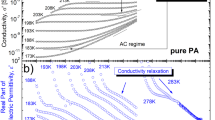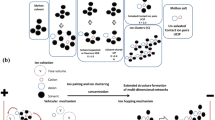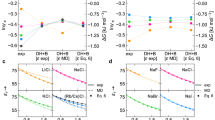Abstract
IN recent years two quite independent theories have been developed to account for the observed electrolyte invasion properties of ion-exchange polymers. Scatchard and Freeman1 suggest that in the application of the Donnan law (1), deviations are best interpreted in terms of the mean activity coefficient of the electrolyte in the exchanger phase, ɣ̄±.  where νc is the number of co-ions in a molecule of electrolyte; νg is the number of counter or gegen ions in a molecule of electrolyte, ν = νc + vg; M is the observed counter-ion concentration; m, the concentration of external electrolyte; m̄, the concentration of imbibed electrolyte; k, a constant; ɣ̄ ± and γ ± are the mean internal and external activity coefficients of the electrolyte, respectively. In accordance with the theory of specific ion interactions2, an expression has been derived (2), in which a and b are constants, to account for variations in ɣ̄± for ion-exchangers based on styrene-divinylbenzene copolymers. This relationship has also been applied to polymethacrylic acid ion-exchangers3.
where νc is the number of co-ions in a molecule of electrolyte; νg is the number of counter or gegen ions in a molecule of electrolyte, ν = νc + vg; M is the observed counter-ion concentration; m, the concentration of external electrolyte; m̄, the concentration of imbibed electrolyte; k, a constant; ɣ̄ ± and γ ± are the mean internal and external activity coefficients of the electrolyte, respectively. In accordance with the theory of specific ion interactions2, an expression has been derived (2), in which a and b are constants, to account for variations in ɣ̄± for ion-exchangers based on styrene-divinylbenzene copolymers. This relationship has also been applied to polymethacrylic acid ion-exchangers3.  It is assumed in this treatment that any deviations resulting from non-uniformity of the exchanger matrix are either negligible or can be eliminated by a small correction to the observed results.
It is assumed in this treatment that any deviations resulting from non-uniformity of the exchanger matrix are either negligible or can be eliminated by a small correction to the observed results.
This is a preview of subscription content, access via your institution
Access options
Subscribe to this journal
Receive 51 print issues and online access
$199.00 per year
only $3.90 per issue
Buy this article
- Purchase on Springer Link
- Instant access to full article PDF
Prices may be subject to local taxes which are calculated during checkout
Similar content being viewed by others
References
Freeman, D. H., J. Phys. Chem., 64, 1048 (1960).
Bronsted, J. M., J. Amer. Chem. Soc., 44, 877 (1922); 45, 2898 (1933).
Gustafson, R. L., J. Phys. Chem., 67, 2549 (1963); 68, 1563 (1964).
Glueckauf, E., and Watts, R. E., Nature, 191, 904 (1961); Glueckauf, E., Proc. Roy. Soc., A, 268, 350 (1962).
Attridge, C. J., and Millar, J. R., J. Chem. Soc., 6053 (1964).
Glueckauf, E., and Watts, R. E., Proc. Roy. Soc., A, 268, 359 (1962).
Crabtree, J. M., and Glueckauf, E., Trans. Farad. Soc., 59, 2639 (1963).
Freeman, D. H., Patel, V. C., and Buchanan, T. M., J. Phys. Chem., 69, 1477 (1965).
Helferrich, F., Ion Exchange (McGraw-Hill, New York, 1962).
Author information
Authors and Affiliations
Rights and permissions
About this article
Cite this article
ATTRIDGE, C. Interpretation of Electrolyte Invasion Data for Ion-exchange Polymers. Nature 211, 1293–1294 (1966). https://doi.org/10.1038/2111293a0
Issue Date:
DOI: https://doi.org/10.1038/2111293a0
Comments
By submitting a comment you agree to abide by our Terms and Community Guidelines. If you find something abusive or that does not comply with our terms or guidelines please flag it as inappropriate.



